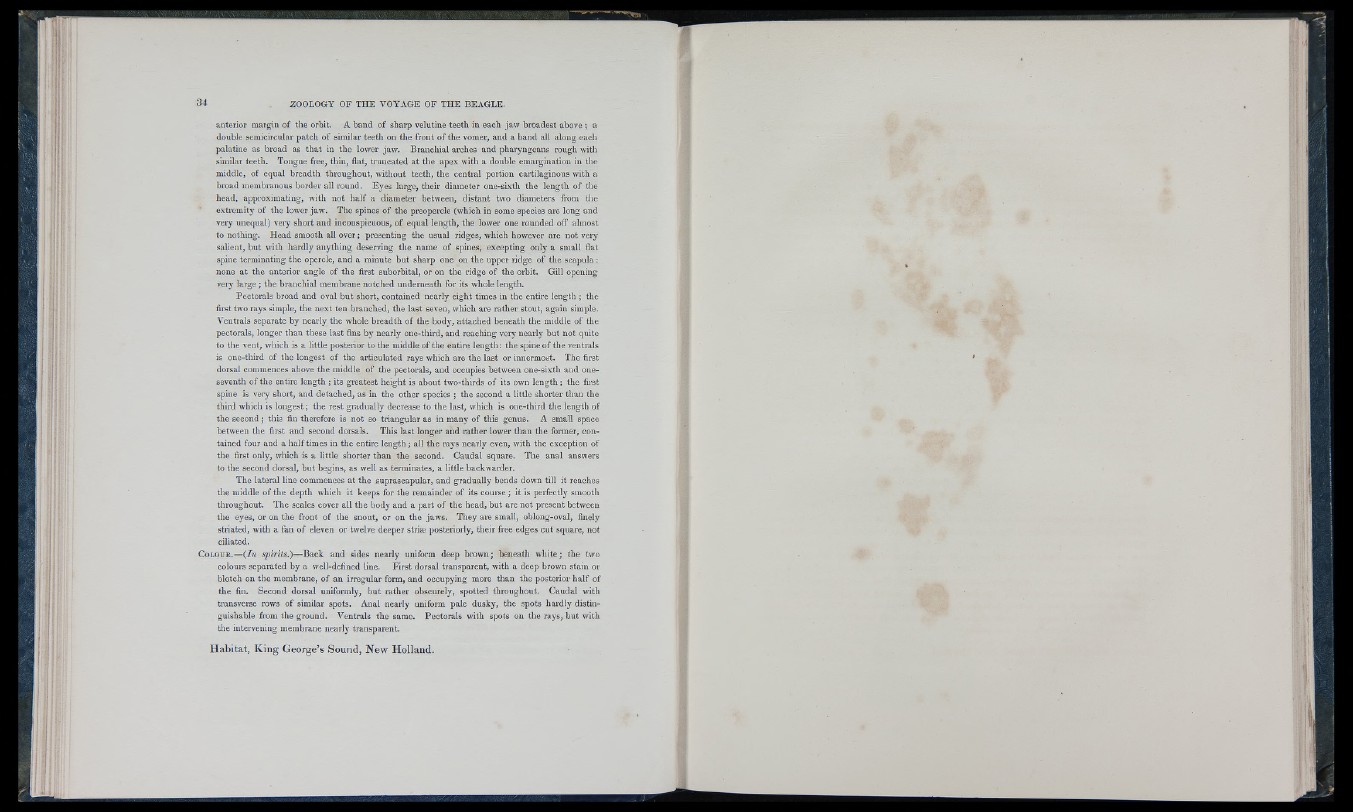
anterior margin of the orbit. A band of sharp velutine teeth in each jaw broadest above ; a
double semicircular patch o f similar teeth on the front of the vomer, and a band all along each
palatine as broad as that in the lower jaw . Branchial arches and pharyngeans rough with
similar teeth. Tongue free, thin, flat, truncated a t the apex with a double emargination in the
middle, of equal breadth throughout, without teeth, the central portion cartilaginous with a
broad membranous border all round. Eyes large, their diameter one-sixth the length of the
head, approximating, with not h alf a diameter between, distant two diameters from the
extremity of the lower jaw . The spines of the preopercle (which in some species are long and
very unequal) veiy short and inconspicuous, of equal length, the lower one rounded off almost
to nothing. Head smooth all over; presenting the usual ridges, which however are not very
salient, but with hardly anything deserving the name of spines, excepting only a small flat
spine terminating the opercle, and a minute h u t sharp one on the upper rjdge of the scapula:
none a t the anterior angle of the first suborbital, or on the ridge of the oi-bit. Gill opening
very large ; the branchial membrane notched underneath for its whole length.
Pectorals broad and oval but short, contained nearly eight times in the entire len g th ; the
first two I'ays simple, the next ten branched, the last seven, which are rather stout, again simple.
Ventrals separate by nearly the whole breadth of the body, attached beneath the middle of the
pectorals, longer than these last fins by nearly one-third, and reaching very nearly but not quite
to the vent, which is a little posterior to the middle of the entire len gth : the spine of the ventrals
is one-third of the longest of the articulated rays which are the last or innermost. The first
dorsal commences above the middle of the pectorals, aud occupies between one-sixth and one-
seventh of the entire length ; its greatest height is about two-thirds of its own length ; the first
spine is very short, and detached, as in the other species ; the second a little shorter than the
third which is longest; the rest gradually decrease to the last, which is one-third the length of
the second; this fin therefore is not so triangular as in many of this genus. A small space
between the first and second dorsals. This last longer and rather lower than tlie former, contained
four and a h alf times in the entire length; all the rays nearly even, with the exception of
the first only, which is a little shorter than the second. C audal square. The anal answers
to the second dorsal, but begins, as well as terminates, a little backwarder.
The lateral line commences at the suprascapular, and gradually bends down till it reaches
the middle of the depth which it keeps for the remainder of its cou rse; it is perfectly smooth
throughout. The scales cover all the body and a part of the head, but are not present between
the eyes, or on the front of the snout, or on the jaw s. They are small, oblong-oval, finely
striated, with a fan o f eleven or twelve deeper striee posteriorly, their free edges cut square, not
ciliated.
C o l o u r .— (In spirits.)— B ack and sides nearly uniform deep brown; beneath w hite; the two
colours separated by a well-defined line. First dorsal transparent, with a deep brown stain or
blotch on the membrane, of an irregular form, and occupying more than the posterior h alf of
the fin. Second dorsal uniformly, but rather obscurely, spotted throughout. C audal with
transverse rows o f similar spots. Anal nearly uniform pale dusky, the spots hardly distinguishable
from the ground. Ventrals the same. Pectorals with spots on the rays, but with
the intervening membrane nearly transparent.
Habitat, King George’s Sound, New Holland.